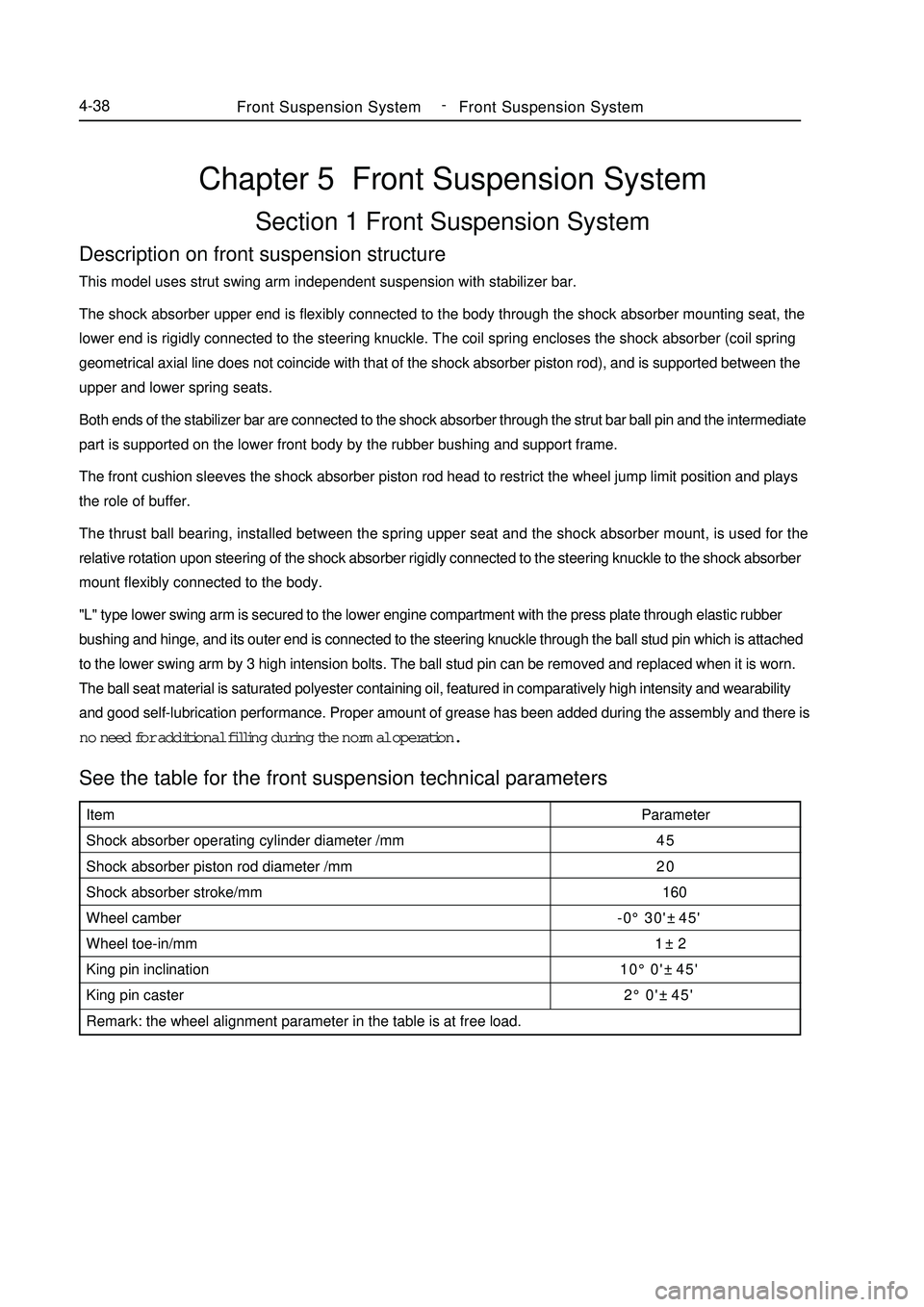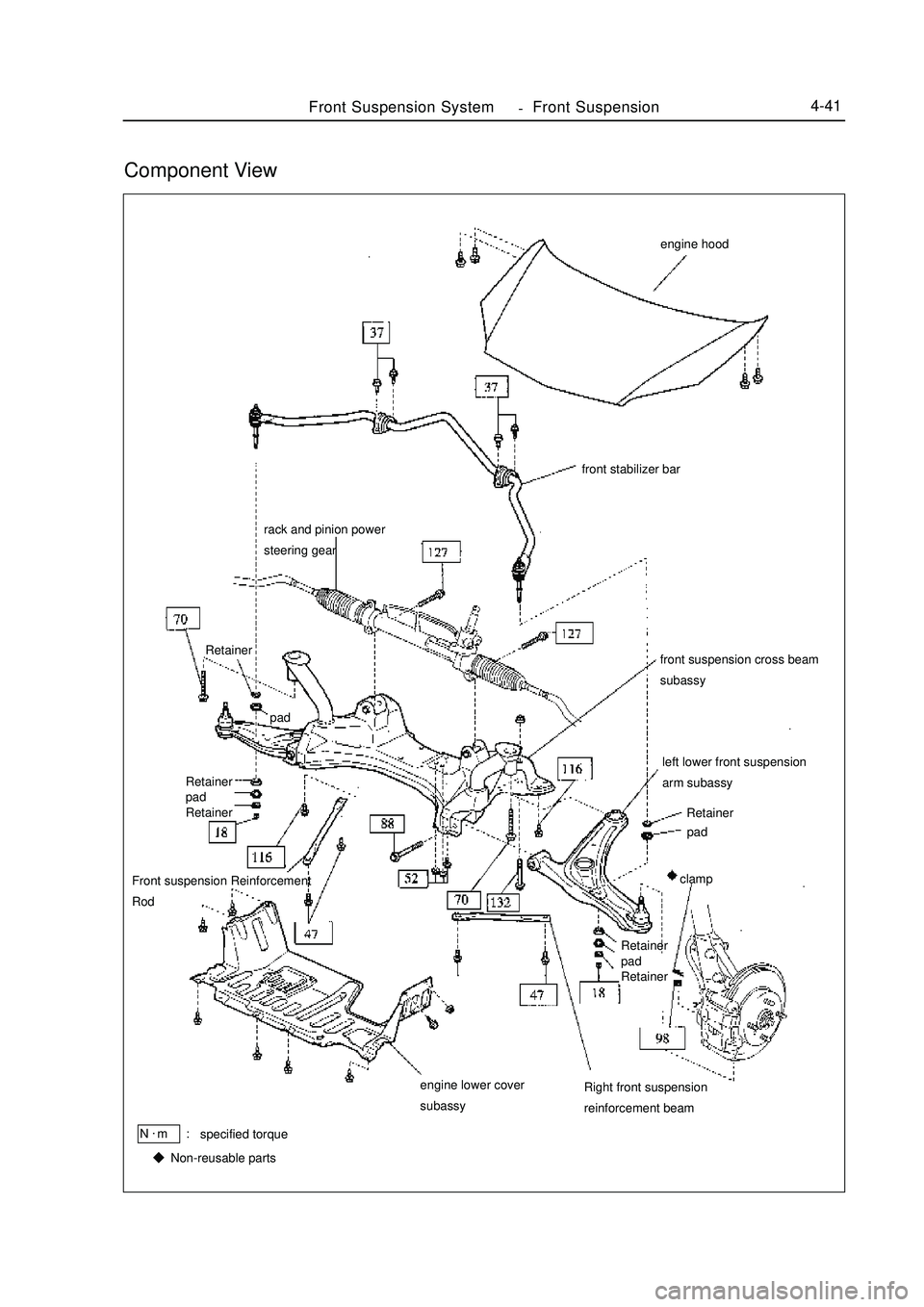GEELY MK 2008 Workshop Manual
Manufacturer: GEELY, Model Year: 2008, Model line: MK, Model: GEELY MK 2008Pages: 416, PDF Size: 25.19 MB
Page 111 of 416

Replacement1. Remove front wheel
2. Remove left front brake caliper assembly
3. Remove front brake disc
4. Remove left front axle hub bolt
Using a ball joint puller and a screwdriver or similar, remove the
left axle hub bolt.
5. Install left front axle hub bolt
(1) As shown in the illustration, install the gasket and nut on the
new left axle hub bolt.
(2) Using a screwdriver or similar,hold the left axle hub subassembly,
install the left axle hub bolt by tightening the nut.
6. Install front brake disc
7. Install left front brake caliper assembly
8. Install front wheel
Torque: 103N.mPropeller Shaft/DriveshaftFront Wheel Hub4-34 The replacement of the right front axle hub subassembly is the same as that of the left one.Washer
Nut -
Page 112 of 416

Propeller Shaft/DriveshaftRear Wheel Hub and Bearing Assembly4-35Section 4 Rear Wheel Hub and Bearing AssemblyComponent ViewRear Axle Hub UnitBrake Drum Assembly
specified torqueN.
m :Slip Control Sensor Wire Harness
With ABS
Left Rear Axle Hub Bolt - Non-reusable parts
Page 113 of 416

Replacement1. Remove rear wheel
2. Remove rear wheel brake drum subassembly
3. Remove slip control sensor wire harness (with ABS)
4. Remove left rear axle hub and bearing assembly
Remove 4 bolts and left axle hub and bearing assembly.
5. Install left rear axle hub and bearing assembly
Install left axle hub and bearing assembly with 4 bolts
Torque: 63N.m
6. Connect slip control sensor wire harness (with ABS)
Notice:
Do not twist the sensor wire harness during connection.
7. Check bearing backlash
8. Check axle hub deviation
9. Install rear wheel brake drum subassembly
10. Install rear wheel
Torque: 103N.m
11. Check as vehicle speed sensor signal (with ABS)Propeller Shaft/DriveshaftRear Wheel Hub and Bearing Assembly4-36 -
Page 114 of 416

Propeller Shaft/DriveshaftRear Wheel Hub and Bearing Assembly4-37Replacement1. Remove rear wheel
2. Remove rear wheel brake drum subassembly
3. Remove left rear wheel axle hub bolt
Using a ball joint puller and a screwdriver or similar, remove the
left axle hub bolt.
4. Install left rear wheel axle hub bolt
(1) As shown in the illustration, install the gasket and nut on the
new left axle hub bolt.
(2) Using a screwdriver or similar, hold the left axle hub subassembly,
install the left axle hub bolt by tightening the nut.
5. Install rear brake drum subassembly
6. Install rear wheel
Torque: 103N.m The replacement of the right rear axle hub and bearing assembly is the same as that of the left one.Washer
Nut -
Page 115 of 416

Chapter 5 Front Suspension SystemSection 1 Front Suspension SystemDescription on front suspension structureThis model uses strut swing arm independent suspension with stabilizer bar.
The shock absorber upper end is flexibly connected to the body through the shock absorber mounting seat, the
lower end is rigidly connected to the steering knuckle. The coil spring encloses the shock absorber (coil spring
geometrical axial line does not coincide with that of the shock absorber piston rod), and is supported between the
upper and lower spring seats.
Both ends of the stabilizer bar are connected to the shock absorber through the strut bar ball pin and the intermediate
part is supported on the lower front body by the rubber bushing and support frame.
The front cushion sleeves the shock absorber piston rod head to restrict the wheel jump limit position and plays
the role of buffer.
The thrust ball bearing, installed between the spring upper seat and the shock absorber mount, is used for the
relative rotation upon steering of the shock absorber rigidly connected to the steering knuckle to the shock absorber
mount flexibly connected to the body.
"L" type lower swing arm is secured to the lower engine compartment with the press plate through elastic rubber
bushing and hinge, and its outer end is connected to the steering knuckle through the ball stud pin which is attached
to the lower swing arm by 3 high intension bolts. The ball stud pin can be removed and replaced when it is worn.
The ball seat material is saturated polyester containing oil, featured in comparatively high intensity and wearability
and good self-lubrication performance. Proper amount of grease has been added during the assembly and there is
no need for additional filling during the normal operation.See the table for the front suspension technical parametersFront Suspension SystemFront Suspension System4-38Item
Shock absorber operating cylinder diameter /mm
Shock absorber piston rod diameter /mm
Shock absorber stroke/mm
Wheel camber
Wheel toe-in/mm
King pin inclination
King pin caster
Remark: the wheel alignment parameter in the table is at free load.Parameter
45
20
160
-0°30'±45'
1±2
10°0'±45'
2°0'±45' -
Page 116 of 416

Suspected Area
1. Tires (Worn or improperly inflated)
2. Wheel alignment (Incorrect)
3. Steering system joint (Loose or worn)
4. Hub bearing (Worn)
5. Steering gear (Out of adjustment or worn)
6. Suspension parts (Worn or damaged)
1. Vehicle (Overloaded)
2. Spring (stiffness not comply with or damage)
3. Shock absorber (Worn)
1. Tire (Worn or improperly inflated)
2. Steering linkage (Loose or damaged)
3. Stabilizer bar (Bent or broken)
4. Shock absorber (Worn or damaged)
1. Tire (Worn or improperly inflated)
2. Tire (Dynamic balance is not as specified)
3. Shock absorber (Worn or damaged)
4. Wheel alignment (Incorrect)
5. Ball stud pin (Worn or damaged)
6. Hub bearing (Worn or damaged)
7. Steering linkage (Loose or worn)
8. Steering gear (Out of adjustment or worn)
1. Tire (Worn or improperly inflated)
2. Wheel alignment (Incorrect)
3. Shock absorber (Worn or damaged)
4. Suspension parts (Worn or damaged)Symptom Table Use the table below to help you find the cause of the problem. The numbers indicate the priority of the likely
cause of the problem. Check each part in order. If necessary, replace parts.
Symptom
Off track
Body Descent
Sways
Front wheel shimmy
Abnormal tire wearFront Suspension System-Front Suspension System4-39
Page 117 of 416

Component ViewSection 2 Front Suspensionleft front suspension
bracket dust cover
left front suspension
bracket subassembly
left upper front
helical spring seat
left upper helical
spring pad
left front
spring
bumperFront Suspension SystemFront Suspension4-40left front shock absorber
assembly suspension support
front shock absorber with
helical spring
With/ ABS:
left front vehicle
speed sensor
brake hoseleft front helical springleft front suspension
bracket dust seal
specified torqueN.
m : - Non-reusable parts
Page 118 of 416

left lower front suspension
arm subassyFront Suspension SystemFront Suspension4-41rack and pinion power
steering gear
engine lower cover
subassyRight front suspension
reinforcement beam Front suspension Reinforcement
RodComponent Viewengine hood
front stabilizer bar
front suspension cross beam
subassy
Retainer
pad
clamp
Retainer
pad
Retainer Retainer
pad
RetainerRetainer
pad
specified torqueN.
m :
Non-reusable parts -
Page 119 of 416

Front Suspension SystemFront Suspension4-42Component Viewleft front stabilizer bar
bracket
bushing
retainer
clamp left lower front suspension
arm subassybushing right front stabilizer bar bracket
front stabilizer bar
pad
front stabilizer bar bolt
retainer
pad retainerretainer
retainer
retainer
retainerpad pad
pad padpad retainer
Front stabilizer bar bolt
specified torqueN.
m :retainer
retainerpad - Non-reusable parts
Page 120 of 416

Section 3 Front Wheel AlignmentAdjustment:1. Check tire
2. Measure the vehicle height
Vehicle height:Tire sizeFront1 (mm)Rear2 (mm)
175 / 65R14 82H191 265
185 / 60R15 84H192 265Front Suspension System-Front Wheel Alignment4-43 1.front measure point
Measure the distance between the ground and the front underside
suspension mounting bolt center
2.rear measure point
Measure the distance between the ground and the rear axle beam mounting bolt center
Notice:
Before the wheel alignment,adjust the body to the specified height.If the body height is out of spec,adjustment
shall be done by pressing or raising vehicle body.
3. Check the Toe-in
Toe-in:
If the toe-in is out of spec, adjust the ends of rack.
4. Adjust the Toe-in
(1) Remove the clamp of the rack boot
(2) Loose the jam nut of tie rod
(3) Adjust the Toe-in by rotating the same turns of both ends of
rack.
Tips: Adjust the toe-in to the intermediate value of spec.
(4)Make sure the same length for both ends
The length difference of left and right: 1.5mm or smaller
(5)Tighten the jam nut of the tie rod
Torque: 47N.m
(6)Seat the boot and crimp the clamp
Tips: rack boot must not be twistedFront
Rear
Front